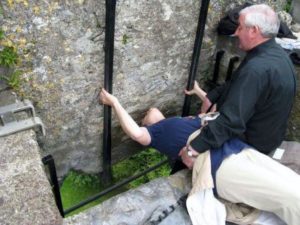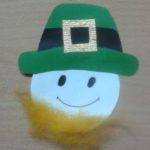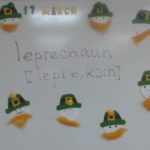Saint Patrick is the patron saint and national apostle of Ireland. St Patrick is credited with bringing Christianity to Ireland. Most of what is known about him comes from his two works; the Confessio, a spiritual autobiography, and his Epistola, a denunciation /dɪˌnʌnsiˈeɪʃən/ осуждение of British mistreatment of Irish Christians.
According to different versions of his life story it is said that he was born in Britain, around 385AD. His parents Calpurnius and Conchessa were Roman citizens living in either Scotland or Wales. As a boy of 14 he was captured and taken to Ireland where he spent six years in slavery herding sheep. He returned to Ireland in his 30s as a missionary among the Celtic pagans.
Many people ask the question «Why is the Shamrock the National Flower of Ireland?» The reason is that St. Patrick used it to explain the Holy Trinity to the pagans. Saint Patrick is believed to have been born in the late fourth century, and is often confused with Palladius, a bishop who was sent by Pope Celestine in 431 to be the first bishop to the Irish believers in Christ.
In the custom known as “drowning the shamrock”, the shamrock that has been worn on a lapel or hat is put in the last drink of the evening.
Saint Patrick is most known for driving the snakes from Ireland. It is true there are no snakes in Ireland, but there probably never have been – the island was separated from the rest of the continent at the end of the Ice Age. As in many old pagan religions, serpent symbols were common and often worshipped. Driving the snakes from Ireland was probably symbolic of putting an end to that pagan practice. While not the first to bring christianity to Ireland, it is Patrick who is said to have encountered the Druids at Tara and abolished their pagan rites. The story holds that he converted the warrior chiefs and princes, baptizing them and thousands of their subjects in the “Holy Wells” that still bear this name.
There are several accounts of Saint Patrick’s death. One says that Patrick died at Saul, Downpatrick, Ireland, on March 17, 460 A.D. His jawbone was preserved in a silver shrine and was often requested in times of childbirth, epileptic fits, and as a preservative against the “evil eye.” Another account says that St. Patrick ended his days at Glastonbury, England and was buried there. The Chapel of St. Patrick still exists as part of Glastonbury Abbey. Today, many Catholic places of worship all around the world are named after St. Patrick, including cathedrals in New York and Dublin city.
St. Patrick’s Day Facts
- Patrick’s Day is observed on the 17th of March and it celebrates St Patrick who is said to have died on that date.
- In Ireland people wear small bunches of shamrocks on their clothes to celebrate the holiday. Children wear orange, white and green badges, and women wear green ribbons.
- The Irish flag is green, orange and white.
- Four-leaf clovers are considered to be lucky. Each leaf means something: hope, faith, love and luck.
- There are 10, 000 three-leaf clovers for every four-leaf clover.
- The traditional symbols for St. Patrick’s Day are the shamrock, leprechauns, a harp /hɑːp/арфа, green, the Celtic cross, and the Blarney Stone.
- A toast for St Patrick’s Day, “May the roof above us never fall in, and may we friends beneath it never fall out.”
- In 1903, St Patrick’s Day became an official public holiday in Ireland.
- The first St Patrick’s Day parade in Ireland was held inWaterford in 1903.
- The first St Patrick’s Day parade took place in Russia in 1992. Since 1999, there has been a yearly «Saint Patrick’s Day» festival in Moscow and other Russian cities such as St Petersburg, Yekaterinburg, Voronezh, and Volgograd. In 2017, theRussian Orthodox Church added the feast day of Saint Patrick to its liturgical calendar to be celebrated on 30 March.
Legend of the Blarney Stone
Blarney Castle is a home of the Blarney Stone.
The legend says that an old woman cast a spell on the stone to reward a king who had saved her from drowning/ˈdraʊnɪŋ/ утопление.
Kissing the stone while under the spell gave the king the ability to speak sweetly and convincingly.

It is difficult to reach the stone. Kissers have to lie on their back and bend backward holding iron bars for support.
The word “blarney” means “clever flattering talk”.
Fun Time!
Let’s make a leprechaun!
A leprechaun /ˈleprəkɔːn/ is a type of fairy in Irish folklore. They are usually depicted as little bearded men, wearing a coat and hat, who partake in mischief /ˈmɪstʃɪf/ шалость озорство. They are solitary /ˈsɒlɪtəri/ одинокий creatures who spend their time making and mending shoes and have a hidden pot of gold at the end of the rainbow. If captured by a human, they often grant three wishes in exchange for their freedom.
For this you need:
- green, black, white and yellow construction paper
- a glue stick
- scissors
- markers
- orange wool for felting to make a beard
- Make a hat out of green construction paper.
- Glue on a black stripe with a yellow buckle.
- Cut a face out of white paper and glue a hat to the top of it.
- Draw eyes, a nose, and a smile with a black marker.
- Arrange the orange beard around his face first and then stick it.
- There you have a cute little leprechaun for St. Patrick’s Day!







